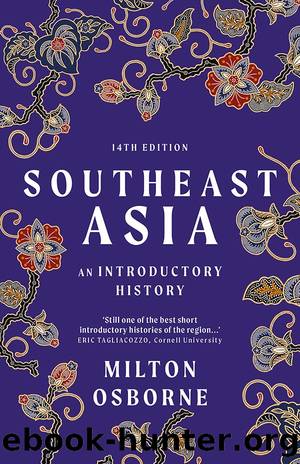Southeast Asia by Milton Osborne

Author:Milton Osborne [Milton Osborne]
Language: eng
Format: epub
Publisher: Allen & Unwin
Published: 2024-02-15T00:00:00+00:00
VIETNAM
In Indonesia the experience of nearly four years of negotiation and fighting to complete the struggle for independence left all but the remotest part of the former Dutch East Indies (West New Guinea) in the hands of the nationalists. The history of the Vietnamese struggle against the French in Vietnam was very different, with a very different outcome. The differences did not only lie in the fact that the Communists in Vietnam led the fight against the French. There was a great difference also in terms of the length of time that the struggle lasted and in the intensity of the military conflict that was joined. Moreover, at the time when the French departed from Vietnam and abandoned their attempt to maintain the posture of a colonial power, in 1954, only half of the territory of Vietnam was under the control of the Vietnamese forces that had inflicted a stunning defeat on their French opponents at the Battle of Dien Bien Phu.
As the prelude to the Second Indochinese War, lasting from the late 1950s until 1975, the Vietnamese war against the French between 1946 and 1954 has remained comparatively little known. The events of the period of major American involvement in the 1960s and 1970s have obscured earlier developments. But unless the events of the years between 1946 and 1954 in Vietnam are understood it is impossible to gain a true sense of why the Vietnamese Communists should later have fought for so long to achieve their goals in the years when the French were no longer the enemy.
The Vietnamese August 1945 Revolution and the subsequent proclamation of independence could not prevent the return of the French. In southern Vietnam, British troops prepared the way for the eventual re-establishment of the colonial administration. In the northern half of the country Nationalist Chinese forces acted as the Alliesâ representatives until the French were ready to reassert themselves. These occupying forces, in both the southern and northern sections of Vietnam, prevented the Communist-led Viet Minh from pursuing its goal of establishing a normal administration. But throughout the country, and in the north in particular where Communist strength was greatest, the Viet Minh laboured to reinforce its position politically while the first of a long series of negotiations was undertaken with the French.
Because of the long period of bitter fighting that followed, it is often forgotten that much of 1946 was spent in FrancoâVietnamese negotiations. Here, at least, there was a similarity between developments in Indonesia and Vietnam. In both cases the anti-colonialist forces were prepared to undertake negotiations with the former colonial powers. But in both cases the expectations of the Indonesians and the Vietnamese were so different from those of the Dutch and the French that there was never any real possibility of achieving a negotiated solution. Perhaps even more than was the case with the Dutch in relation to Indonesia, the immediate post-Second World War governments in France were determined to reassert their control over the former colonial territories in Vietnam, Cambodia and Laos.
Download
This site does not store any files on its server. We only index and link to content provided by other sites. Please contact the content providers to delete copyright contents if any and email us, we'll remove relevant links or contents immediately.
| Central Asia | Southeast Asia |
| China | Hong Kong |
| India | Japan |
| Korea | Pakistan |
| Philippines | Russia |
The Sympathizer by Viet Thanh Nguyen(3622)
The Rape of Nanking by Iris Chang(3617)
World without end by Ken Follett(3069)
Ants Among Elephants by Sujatha Gidla(2978)
Blood and Sand by Alex Von Tunzelmann(2677)
Japanese Design by Patricia J. Graham(2621)
City of Djinns: a year in Delhi by William Dalrymple(2185)
Inglorious Empire by Shashi Tharoor(2143)
Foreign Devils on the Silk Road: The Search for the Lost Treasures of Central Asia by Peter Hopkirk(2117)
In Order to Live: A North Korean Girl's Journey to Freedom by Yeonmi Park(2106)
Tokyo by Rob Goss(2067)
India's biggest cover-up by Dhar Anuj(2035)
India's Ancient Past by R.S. Sharma(2033)
The Great Game: On Secret Service in High Asia by Peter Hopkirk(2017)
Tokyo Geek's Guide: Manga, Anime, Gaming, Cosplay, Toys, Idols & More - The Ultimate Guide to Japan's Otaku Culture by Simone Gianni(1992)
Goodbye Madame Butterfly(1979)
The Queen of Nothing by Holly Black(1833)
Living Silence in Burma by Christina Fink(1784)
Batik by Rudolf Smend(1774)
